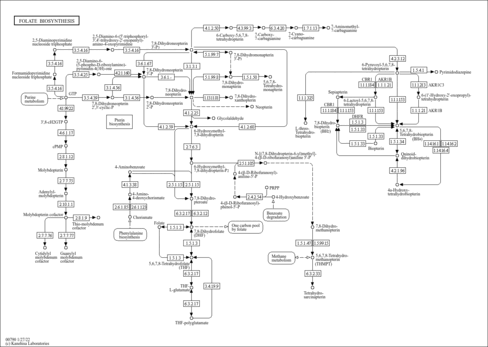| Record Information |
|---|
| Version | 1.0 |
|---|
| Created at | 2020-04-17 19:15:58 UTC |
|---|
| Updated at | 2020-11-18 16:39:27 UTC |
|---|
| CannabisDB ID | CDB005166 |
|---|
| Secondary Accession Numbers | Not Available |
|---|
| Cannabis Compound Identification |
|---|
| Common Name | Dihydroneopterin phosphate |
|---|
| Description | Dihydroneopterin phosphate belongs to the class of organic compounds known as biopterins and derivatives. These are coenzymes containing a 2-amino-pteridine-4-one derivative. They are mainly synthesized in several parts of the body, including the pineal gland. Dihydroneopterin phosphate is involved in the folate biosynthesis pathway. Dihydroneopterin phosphate is a strong basic compound (based on its pKa). Dihydroneopterin phosphate exists in all living species, ranging from bacteria to humans. Dihydroneopterin phosphate is produced from 2-Amino-4-hydroxy-6-(erythro-1,2,3-trihydroxypropyl)dihydropteridine. Dihydroneopterin phosphate is expected to be in Cannabis as all living plants are known to produce and metabolize it. |
|---|
| Structure | |
|---|
| Synonyms | | Value | Source |
|---|
| 2-Amino-4-hydroxy-6-(erythro-1,2,3-trihydroxypropyl)dihydropteridine phosphate | ChEBI | | 7,8-Dihydroneopterin 3'-phosphate | Kegg | | 2-Amino-4-hydroxy-6-(erythro-1,2,3-trihydroxypropyl)dihydropteridine phosphoric acid | Generator | | 7,8-Dihydroneopterin 3'-phosphoric acid | Generator | | Dihydroneopterin phosphoric acid | Generator | | 2-Amino-6-[(1S,2R)-1,2-dihydroxy-3-(phosphonooxy)propyl]-7,8-dihydro-4(3H)-pteridinone | HMDB | | 7,8-Dihydroneopterin 3’-phosphate | HMDB | | Dihydroneopterin phosphate | HMDB |
|
|---|
| Chemical Formula | C9H14N5O7P |
|---|
| Average Molecular Weight | 335.21 |
|---|
| Monoisotopic Molecular Weight | 335.0631 |
|---|
| IUPAC Name | [(2R,3S)-3-(2-amino-4-oxo-1,4,7,8-tetrahydropteridin-6-yl)-2,3-dihydroxypropoxy]phosphonic acid |
|---|
| Traditional Name | (2R,3S)-3-(2-amino-4-oxo-7,8-dihydro-1H-pteridin-6-yl)-2,3-dihydroxypropoxyphosphonic acid |
|---|
| CAS Registry Number | Not Available |
|---|
| SMILES | NC1=NC2=C(N=C(CN2)[C@H](O)[C@H](O)COP(O)(O)=O)C(=O)N1 |
|---|
| InChI Identifier | InChI=1S/C9H14N5O7P/c10-9-13-7-5(8(17)14-9)12-3(1-11-7)6(16)4(15)2-21-22(18,19)20/h4,6,15-16H,1-2H2,(H2,18,19,20)(H4,10,11,13,14,17)/t4-,6+/m1/s1 |
|---|
| InChI Key | PLSQMGZYOGSOCE-XINAWCOVSA-N |
|---|
| Chemical Taxonomy |
|---|
| Description | Belongs to the class of organic compounds known as biopterins and derivatives. These are coenzymes containing a 2-amino-pteridine-4-one derivative. They are mainly synthesized in several parts of the body, including the pineal gland. |
|---|
| Kingdom | Organic compounds |
|---|
| Super Class | Organoheterocyclic compounds |
|---|
| Class | Pteridines and derivatives |
|---|
| Sub Class | Pterins and derivatives |
|---|
| Direct Parent | Biopterins and derivatives |
|---|
| Alternative Parents | |
|---|
| Substituents | - Biopterin
- Aminopyrimidine
- Pyrimidone
- Secondary aliphatic/aromatic amine
- Monoalkyl phosphate
- Organic phosphoric acid derivative
- Phosphoric acid ester
- Pyrimidine
- Alkyl phosphate
- Heteroaromatic compound
- Vinylogous amide
- 1,2-diol
- Ketimine
- Secondary alcohol
- Azacycle
- Organic 1,3-dipolar compound
- Secondary amine
- Propargyl-type 1,3-dipolar organic compound
- Amine
- Hydrocarbon derivative
- Primary amine
- Organic oxide
- Organooxygen compound
- Organonitrogen compound
- Organopnictogen compound
- Alcohol
- Imine
- Organic oxygen compound
- Organic nitrogen compound
- Aromatic heteropolycyclic compound
|
|---|
| Molecular Framework | Aromatic heteropolycyclic compounds |
|---|
| External Descriptors | |
|---|
| Ontology |
|---|
|
| Disposition | Source: |
|---|
| Physical Properties |
|---|
| State | Solid |
|---|
| Experimental Properties | | Property | Value | Reference |
|---|
| Melting Point | Not Available | Not Available | | Boiling Point | Not Available | Not Available | | Water Solubility | Not Available | Not Available | | logP | Not Available | Not Available |
|
|---|
| Predicted Properties | [] |
|---|
| EI-MS/GC-MS | | Type | Description | Splash Key | View |
|---|
| Predicted GC-MS | Dihydroneopterin phosphate, non-derivatized, Predicted GC-MS Spectrum - 70eV, Positive | splash10-0005-8911000000-53dc19c24dbe99c4297c | Spectrum | | Predicted GC-MS | Dihydroneopterin phosphate, 2 TMS, Predicted GC-MS Spectrum - 70eV, Positive | splash10-03dj-9412400000-711e5bff9c050e651d6f | Spectrum | | Predicted GC-MS | Dihydroneopterin phosphate, non-derivatized, Predicted GC-MS Spectrum - 70eV, Positive | Not Available | Spectrum |
|
|---|
| MS/MS | | Type | Description | Splash Key | View |
|---|
| Predicted MS/MS | Predicted LC-MS/MS Spectrum - 10V, Positive | splash10-000i-1149000000-5fbd207fae24db394e97 | 2015-09-15 | View Spectrum | | Predicted MS/MS | Predicted LC-MS/MS Spectrum - 20V, Positive | splash10-01p9-3984000000-b1316677bed07bd7f55d | 2015-09-15 | View Spectrum | | Predicted MS/MS | Predicted LC-MS/MS Spectrum - 40V, Positive | splash10-03ka-1910000000-4900a3a0b1a8c45967d0 | 2015-09-15 | View Spectrum | | Predicted MS/MS | Predicted LC-MS/MS Spectrum - 10V, Negative | splash10-003u-6519000000-d97b00fd24549be11a57 | 2015-09-15 | View Spectrum | | Predicted MS/MS | Predicted LC-MS/MS Spectrum - 20V, Negative | splash10-004i-9200000000-17032e05ed4e9517e10d | 2015-09-15 | View Spectrum | | Predicted MS/MS | Predicted LC-MS/MS Spectrum - 40V, Negative | splash10-004i-9000000000-767fc48b2593a3849c9a | 2015-09-15 | View Spectrum | | Predicted MS/MS | Predicted LC-MS/MS Spectrum - 10V, Positive | splash10-000i-0049000000-34ddec995961538a2b69 | 2021-09-23 | View Spectrum | | Predicted MS/MS | Predicted LC-MS/MS Spectrum - 20V, Positive | splash10-00dr-0093000000-9db5d730be4336945735 | 2021-09-23 | View Spectrum | | Predicted MS/MS | Predicted LC-MS/MS Spectrum - 40V, Positive | splash10-004i-1910000000-fbf02f9608828a708ae3 | 2021-09-23 | View Spectrum | | Predicted MS/MS | Predicted LC-MS/MS Spectrum - 10V, Negative | splash10-003r-9008000000-046b0ad106139a51dfcc | 2021-09-24 | View Spectrum | | Predicted MS/MS | Predicted LC-MS/MS Spectrum - 20V, Negative | splash10-004i-9000000000-a3ddbffe59a79724cf9e | 2021-09-24 | View Spectrum | | Predicted MS/MS | Predicted LC-MS/MS Spectrum - 40V, Negative | splash10-004i-9100000000-3e79dacf1a5decbc02d9 | 2021-09-24 | View Spectrum |
|
|---|
